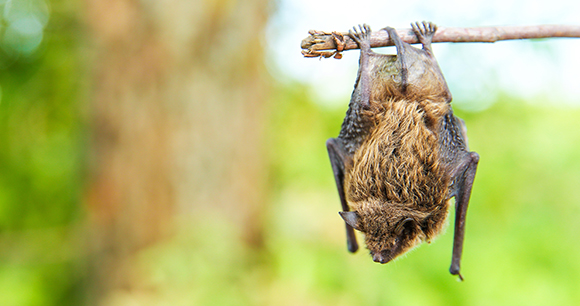Use of Roost Boxes by Bats Evicted from Manmade Structures
by Isabelle Zoccolo, Kathleen Kerwin, and Brooke Maslo, Rutgers University
North American bats have an estimated economic value of $23 billion annually due to their natural role as insect pest regulators. These bats have faced a significant decline due to white-nose syndrome (a fungal disease of hibernating bats), among other threats. Despite their ecological importance and conservation status, bats are sometimes labeled as pests because some species (those that typically roost in tree cavities) have adapted to roosting in manmade structures. Roost sites are used as maternity colonies (where females give birth to and raise pups) as well as hibernation sites.

Due to health concerns (e.g., rabies) surrounding bat-human interactions, wildlife control professionals are often hired to exclude bats from structures where they are roosting. This is done by installing one-way doors to ensure the bats can leave but not re-enter a manmade structure. Many states do not protect bats against harassment, injury, or mortality, and many do not provide guidelines for properly excluding bats. Even in states that do require “humane” bat exclusions, the methods can cause significant stress, lowered reproductive success, and potential mortality to the evicted individuals due to a loss of refuge when food resources are scarce and metabolic requirements are high. Providing alternative roost sites may lessen the negative impacts of bat evictions and successfully resolve bat-human conflicts.
Thanks to support from a Christine Stevens Wildlife Award, we were able to test the effectiveness of providing artificial roost structures (i.e., bat boxes) to minimize the negative impacts to bats evicted from manmade structures.
This study used 108 roost boxes throughout New Jersey, installed through conservation programs sponsored by the Rutgers University Wildlife Conservation and Management Program or the Conserve Wildlife Foundation of New Jersey. Both programs offer roost boxes to homeowners performing bat exclusions, as well as to individuals interested in attracting bats to their yards. For each roost box, we noted when the boxes were installed, where the boxes were installed (either on a manmade structure or tree), and if the installation was preceded by an exclusion. Over the course of several years, these boxes were monitored for bat presence. A box was considered used if, during any survey, bats were observed inside of or exiting from the box, or if there was fresh bat feces beneath the box.
Only one roost box not mounted on a building was used by bats. Conversely, 35 percent of roost boxes on a building with no history of exclusion were inhabited by bats, and 86 percent of roost boxes on a building where an exclusion had occurred were inhabited by bats. This suggests that mounting roost boxes on a building should be prioritized over non-building mounting locations, particularly after an exclusion. Although roost boxes are beneficial to recently evicted bats, our results suggest that they generally do not serve as supplemental habitat for cavity-roosting bat communities. However, they are still useful tools from a public outreach perspective and may result in net benefits for some cavity-roosting species over time.
This study was funded by the Christine Stevens Wildlife Awards program. Learn more about this program or view additional studies.
Program Terms: Terrestrial Wildlife
AWI Quarterly Terms: Feature Article
Related News
IUCN Reaffirms Long-Tailed Macaques’ Endangered Status Despite Industry Pressure
In Program: Terrestrial WildlifeThe International Union for Conservation of Nature (IUCN) today released an update to its Red List of Threatened Species. The update revealed that the long-tailed...
AWI Funds Research to Alleviate Human-Wildlife Conflicts, Animal Suffering
In Program: Terrestrial WildlifeThe Animal Welfare Institute (AWI) announced today the eight recipients of its Christine Stevens Wildlife Award who are developing humane solutions to human-wildlife conflicts and...
Refuge from Cruel Trapping Act Reintroduced to Protect Wildlife and Pets on Public Lands
In Program: Companion Animals, Terrestrial WildlifeThe Animal Welfare Institute (AWI) endorses the Refuge from Cruel Trapping Act, reintroduced today in the US House of Representatives by Rep. Jerrold Nadler (D-NY)....
Colorado Now Leads Country in Comprehensive Approach to Fighting Wildlife Trafficking
In Program: Terrestrial WildlifeToday, Colorado Gov. Jared Polis signed S.B. 25-168 into law to combat wildlife trafficking. The bipartisan legislation, which is unique among states for the number...